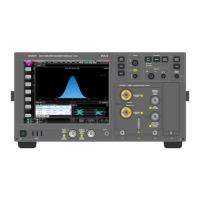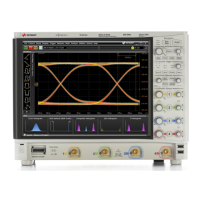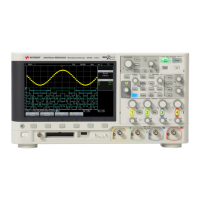200 Keysight InfiniiVision 1200 X-Series and EDUX1052A/G Oscilloscopes User's Guide
18 Frequency Response Analysis
• Sources — opens a menu for specifying the oscilloscope channels probing the
DUT's input and output.
• Start Freq, Stop Freq — specifies the start frequency and the stop frequency in
the sweep.
To toggle between coarse, fine, and log scale decade adjustment, press this
softkey again or push the Entry knob. The "~" character appears in the
softkey label when fine adjustment is enabled, and the "10
X
" characters
appear when decade adjustment is enabled.
Because the stop frequency value must be greater than the start value,
increasing the start value can also cause the stop value to be increased.
Likewise, decreasing the stop value can also cause the start value to be
decreased.
• Amplitude — specifies the waveform generator amplitude.
• Output Load — specifies the waveform generator expected output load
impedance.
The output impedance of the Gen Out signal is fixed at 50 ohms. However,
the output load selection lets the waveform generator display the correct
amplitude and offset levels for the expected output load. If the actual load
impedance is different than the selected value, the displayed amplitude and
offset levels will be incorrect.
• Points — sets the total number of points to use for the sweep.
The number of points may be limited depending on the specified frequency
range.
5 Press the Back key to return the the Analyze menu.
6 Press the Run Analysis softkey.
To view and save the analysis results
After the frequency response analysis completes, the results are displayed in a
Bode plot chart. You can press the Move Marker softkey and turn the Entry knob to
move a marker across the chart to see the measured gain and phase values at
each frequency point.

